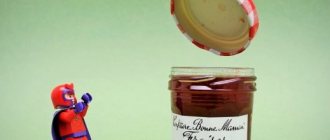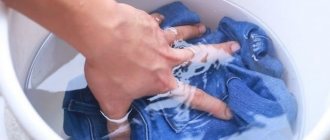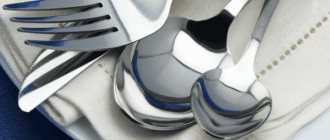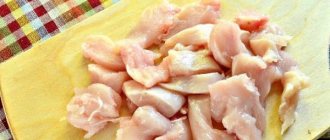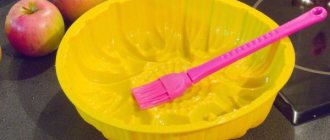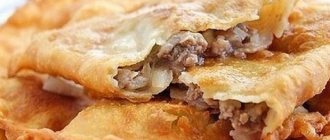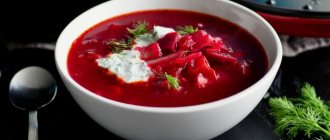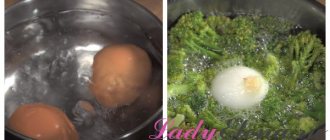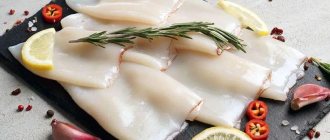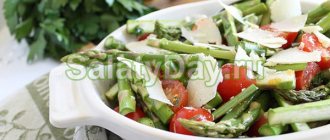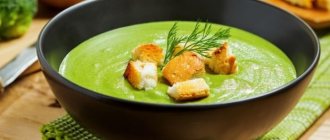Traditional methods
Retail chains offer an incredible number of new-fangled separator designs, but many prefer simple but very effective methods for separating two egg components. Try them out too.
Sleight of hand
Break the egg on the edge of a plate or do it with a knife.
With experience you will definitely learn how to break an egg without damaging the yolk, but at first you will have to act delicately.
Pour the contents into a deep plate.
The yolk will be in the middle of the container surrounded by the spread white.
Grasp it with your fingers gently but firmly and remove it from the plate.
Pour out the protein
You can simply pour out the transparent part of the egg!
Make holes on the sharp and blunt sides of the egg. One of them should be wider. Place the egg over a plate and let the white drip through the wider hole. It won't be fast, so be patient.
To speed up separation, you can slightly shake the egg from side to side or put your lips against the smaller hole and blow into it with force. The white will leak out, but the yolk will remain in the shell.
How experienced chefs do it
Over a plate, with the blunt part of a knife or a fork, beat the shell in the center of the egg and confidently break it into 2 halves.
Some of the protein will immediately end up in the plate.
Place everything that is left into one of the shells.
Pour the rest of the egg from one half of the shell to the other, holding it over the container until all the white has flowed into it.
How to extract the yolk from an ostrich egg?
A special feature of the ostrich egg is its shell, which is almost impossible not to damage during the process of extracting the insides of the product.
How to extract the yolk from an ostrich egg
For the process to be successful, professional chefs use the only experimentally proven algorithm for separating the yolk from the white:
- In the blunt part of the egg, draw a circle with a diameter of about 1 cm. Then, along the marked boundaries, you need to make a hole using a thick needle. It is not recommended to exceed the specified size, as this may affect the final result (the yolk will leak out along with the white).
- Using a thick needle, make another hole in the center at the opposite end of the egg.
- Keep the product over a deep bowl with the large hole facing down for 10 minutes. If necessary, the plate can be replaced with a jar, the size of the neck of which will allow you to place the egg on it.
- Take the egg in your hands, turn the large hole upside down and shake the remaining contents of the shell with vertical movements.
- Repeat step 3, while speeding up the process with a directed stream of air blown from the cook’s mouth into a small hole in the top of the egg.
When separating the yolk and white contained in an ostrich egg, it is not recommended to use sharp, thick objects. If they act incorrectly on the shell, it can crack, as a result of which the yolk is irrevocably mixed with the protein consistency.
Separate using improvised means
You can quickly separate the components of eggs using various means that both an experienced cook and a person far from cooking are sure to find at home - an ordinary funnel or even an empty plastic bottle . Using any such device is as easy as shelling pears.
Rinse and dry the plastic bottle.
Break the egg and place on a flat plate.
Squeeze the bottle on both sides, releasing the air.
The neck of the vessel should be brought as close as possible to the surface of the yolk and the compression of the bottle should be loosened.
The whole yolk will be easily absorbed into the container.
Now just pour it into the desired container.
Take a factory-made funnel or create one yourself, for example, from whatman paper or printer paper, cutting off the tip of the cone (you should get a hole the size of your little finger). Break the egg and pour the contents into the funnel. Hold it over a plate, where the squirrel will move, leaving its yellow “neighbor” in the shell.
As easy as pie
Take a plastic cup. Heat the knife and make a crescent-shaped cut at the bottom no more than a centimeter wide. Pour in the egg and let the clear substance flow through the hole. You can do the same with a deep plastic spoon.
If you just need the yolk, regardless of its condition, use a syringe without a needle. After carefully breaking the egg, simply draw up the yellow component with a syringe, then all that remains is to empty it.
Option 4 - spill
This method is not performed too quickly, but it still allows you to achieve the desired result. The essence of the method is that the white is poured out, and the yolk remains on the filter or in an imitation of a separator:
- From plain or parchment paper you need to make a cone with a small hole at the bottom. The egg is broken and poured into the cone. The white should slide well into the middle, and the yolk should remain in the cone.
- Using a regular sewing needle or paperclip, the egg is pierced on both sides. One of the holes will be wider than the other, so it is from this side that the protein should pour out. The egg must be tilted towards the cup with the wide hole down and wait until the contents flow out. You can speed up the separation of the protein by slightly moving the shell to the sides, but without shaking.
- Using a flour sieve is also easy to separate the desired portion from the egg. The sieve is placed above the dishes; it is advisable to secure it to free both hands. Then the egg is broken over a sieve, so as not to damage the yolk, and “sifted” with gentle movements. The white will drain, and the yolk will linger on the mesh.
Advice! If there is a need to separate the yolk of sawn eggs, then this procedure must be performed especially carefully. The resource “mschistota.ru” advises not to forget that the shell of quail eggs is very thin, unlike chicken eggs. It is with the help of a sieve that the procedure will be easiest.
By choosing one of the above methods, you can easily separate the egg white and prepare a delicious dish. Good luck and bon appetit!
Special devices for easy separation
Pay attention to the miracle technology - special separators that make it possible to easily separate the whites and yolks.
Judging by reviews on social networks, the most popular separator is a silicone bulb, which copes with the task in a few seconds.
The principle of operation is the same as in the “exercise” with a bottle, it’s just that the pear is more convenient and attractive.
Pour the contents of the egg into a deep plate.
Squeeze the pear with your fingers and bring its neck to the yolk (its diameter corresponds to the circumference of the yolk).
When they touch, release your grip.
The pear will deftly “swallow” the yolk.
There is also a special device in the form of a strainer in stores.
There you can determine the viscous egg substance.
The protein flows out through the mesh, the rest remains in place.
To speed up the process, move and tilt the sieve slightly.
Today you can choose a separator to suit your taste. Thanks to the efforts of the designers, they look very attractive. These include cups with “smile” holes, plates with one or more slits, spoons, and even egg pistols.
Products can be plastic, ceramic, metal, designed for different numbers of eggs, stylish or “funny”. But any such separator is created according to one principle: the protein is given the opportunity to drain through one or more holes, and the rest remains intact and unharmed.
Miracles of technology
Engineers also created high-precision separators, and designers designed them in an elegant style. The lid of the device opens, an egg is poured into the middle, and the lid closes. Then the upper compartment rotates 180° and returns to its original position. The lid opens and - voila! You find the yolk resting separately on the mesh, and the white remains at the bottom of the device.
There are even devices that can accommodate an egg in a shell. They perform the entire procedure independently.
Devices
How and how long to boil soft-boiled eggs after boiling water
If you boil soft-boiled eggs correctly, they will have the property of retaining the greatest amount of beneficial…
Even for such a simple procedure, technological devices and kitchen appliances have been invented. From the simplest, operating on basic principles, to those that can separate components with surgical precision. At home, the easiest way is to use a “pear” or dishes with recesses. The pear works like a plastic bottle - it sucks in the yolk, thereby separating it from the rest. Unlike a bottle, it takes up less space and is much more convenient to use. Dishes with recesses work on the principle of a sieve: sifting out the more fluid part from the heavier one. You can find separators made of silicone, plastic, ceramics and metal, and the design can be any. More advanced devices are used in factories or restaurants where whites or yolks have to be used on an industrial scale.
Important! The separated ingredients can be stored in the refrigerator for several days. So don’t rush to throw away unnecessary whites or yolks: you can use them to cook something next time.
It is possible to separate components from each other at home. This can be done with your hands, carefully breaking the shell and separating the white from the yolk, using available means - a strainer, bottle, spoon or special utensils. Fresh eggs work best when chilled.
Quail eggs
How to properly break quail eggs to separate the whites, since the risk of mixing due to the fragile thin film that holds the yolk is very high?
Use a miniature olive spoon with a hole in the middle.
Break the eggs into a container and then scoop the mixture into a spoon.
You can try pouring the egg directly into a spoon.
Break a miniature egg into a mesh surface.
If the product is fresh, the squirrel will drain easily. If it is slightly stale, roll it on the surface.
Sleight of hand
You can separate the yolk from the white without additional utensils or equipment: just with your hands. There is a risk of droplets getting in, but such methods are the fastest and can be used in any conditions. There are three options: the classic one, the more cunning one, and the one that experienced chefs or housewives use.
Quickly whip egg whites without a mixer or whisk - this is real
Foam from egg whites is used by housewives and confectioners to create cakes, pastries, cookies, muffins and other...
Method one: break the egg on the edge of the plate and pour the entire contents into a container. Try to do this carefully so as not to damage the core - then it will end up in the middle of the puddle and can be easily caught with a strainer or hand. The second method: pierce a hole at one edge and drain the flowing protein through it. Third option: use an advanced method. Stand the egg upright and carefully break the shell in the middle, then break it into two pieces. The heavier contents will end up on one half, and get rid of the surrounding liquid by pouring the white from one shell to the other.
Important! It is best to work with a chilled product: then the components separate from each other much more easily. Place the eggs in the refrigerator for at least half an hour before cooking.
How to prepare eggs
How to prepare eggs
Eggs are a fragile product, so before boiling them, they must be removed from the refrigerator and allowed to cool to room temperature. This is done so that during the cooking process the shell does not burst when in contact with boiling water. To prevent the egg from cracking, you can pierce it with a needle in advance. To do this, insert a needle literally a millimeter into the blunt end of the egg; steam will escape through this hole during cooking.
Before boiling, eggs must be thoroughly washed under running water. Egg lovers are advised to acquire a special brush for washing them; with its help, cleaning the product from germs and bacteria will be much faster and more efficient.
Eggs that were collected less than a week ago should be cooked half a minute longer.
Method 1: Boiled eggs - diet and various dishes
The most common method for separating the yolk from the white is boiled eggs. This option, by separating the components as a direct method, began to be used after the surge in popularity of separate nutrition. Since, previously, boiled eggs were used exclusively for cooking eggs for food.
The process of separating the yolk from the white in this way is simple and does not take much time. Moreover, in this way, you can simultaneously prepare any number of eggs for separation. Which is convenient when preparing any dishes or when sharing meals for several people.
Direct separation occurs after the eggs are fully cooked. Namely, when both the white and the yolk take on a non-liquid state. After removing the shell, you need to carefully cut the white with a knife, breaking it further into pieces and remove the yolk with a teaspoon.
If you are preparing any dish that requires even parts of the white or a completely round yolk, you should cook the eggs for at least 15 minutes in boiling water. And in order to prevent the shell from cracking during cooking, the water must be salted, and the eggs should be lowered into the container before the water boils. Also, for a denser mass of white and yolk, after cooking it is worth holding the already boiled eggs under cold water until they cool completely.
The use of separated yolks and whites in this way is very diverse. For example, preparing various dishes. For example, stuffed eggs with sprats or garlic are made exactly this way. In some cases, the white remains intact, and the yolk is mixed with some ingredients. After the white is cut into equal parts, it is seasoned with a mixture of yolk and something else.
Also, this method is practiced by those who adhere to the principle of separate nutrition. This, by the way, is not unfounded, since the rate of absorption of protein and yolk is different, and the content of elements in them is different.
In addition, there is a huge variety of dishes prepared from separated parts of the egg - from salads to soups and stews. And also, the use of the principle of separation of components in nutrition, separated yolks and whites, is convenient in the case of calculating the content of protein and fat mass of the product. And also to calculate the glycemic level index. These indicators are used to prepare a variety of dietary dishes and create a balanced menu for athletes and people with health problems.
Components in the yolk and white of an egg (per hundred grams):
Boiled protein:
- Calories – 44 k/calories
- Protein – 11 grams
- No fats
- Carbohydrates - 0.8 grams
- Glycemic index - 0
Boiled yolk:
- Calories - 62 k/calories
- Protein - 2 grams
- Fats - 6 grams
- Carbohydrates – 0.1 grams
- Glycemic index - 0
Knowing these product indicators and dividing it into components, you can easily build a menu to suit any needs. For sports nutrition or dietary nutrition, these indicators will certainly be necessary. For example, for people with diabetes, knowing this data, you can correctly calculate the amount of medication needed when eating food containing protein and yolk.
As for other aspects of nutrition, each product has similar characteristics. And it will be easy to regulate the content of all their components, knowing them in detail.
Separating the white from the yolk by boiling is very common and most often, when boiling eggs, no one thinks that its components can be eaten separately. Moreover, use it for your own benefit. For example, protein diets, excluding fats and reducing carbohydrates to a minimum, bring visible results in weight loss, and separate nutrition in general leads to good health and lightness.
How to properly separate the yolk from the white at home
The oldest method of separating eggs is using the shell. It is necessary to break a raw egg over a glass and pour the contents from one shell to another until the clean yellow part of the egg remains in one of the halves and the white is poured into the glass.
This method is not always convenient: the sharp edge of the egg shell can pierce the yolk membrane, part of it will end up in the white part, and then a clean separation of the egg will not work.
Preparation
The separation process itself is quite quick and not difficult, and with experience, mistakes are completely eliminated. To quickly and easily separate the yolks from the whites, prepare the eggs and work area:
- First make sure the egg is fresh. Place it in salted water: the stale one will float, but the good one will sink. Only in a fresh product does the protein easily detach; in an old product it gets stuck.
- Look carefully for cracks or damage to the shell. If there is, then it is better not to use such a product, especially for dishes based on raw eggs.
- To make the task easier, place the product in the refrigerator for 20 minutes.
- Gently rinse the shells with warm water and detergent and dry with a paper towel. This will disinfect products that will be used raw (for protein cream, etc.). If you neglect the cleanliness of the shell, you can get poisoned and diseases such as salmonellosis. Thoroughly wash domestic eggs soiled with chicken droppings.
- If you need to separate the yolks and whites of two or more eggs at once, then prepare several containers. This way, if you make a mistake, you won't ruin the properly separated proteins. This measure will help you safely detect spoiled contents (this step should not be omitted even if you have previously tested the eggs in water).
- All tools (knives, bowls, etc.) must be clean and dry.
Method 3: Frozen eggs - pros and cons
Separating the yolk and white by freezing is more an option driven by necessity than originally intended. Since the process itself is not short, but the result, as a rule, is a change in taste. Naturally, in most dishes, it will be impossible to feel the difference in taste, but when preparing, for example, scrambled eggs, you will be quite noticeable.
When frozen, the structure of both the white and the yolk changes. Therefore, unless clearly necessary, you should not freeze eggs.
Separating the whites and yolks in this way may be justified if a large amount of protein is needed. The yolk, for example, is no longer suitable for omelettes or fried eggs. The process itself begins with the preparation of eggs and containers for their subsequent defrosting.
First of all, you need to wash all the eggs with cold water. And let it dry a little. There is no point in allowing the product to dry completely. If they are wet, they will freeze faster. But it’s also not worth freezing when it’s too wet. Since the shell will most likely burst.
After the eggs are washed, you need to place them in the freezer for about three hours. And during this time, wash the dishes where the eggs will later be placed for defrosting. The dishes should be left at room temperature for the entire freezing period.
To separate the yolks and whites by freezing, do not overfreeze the eggs. Because if frozen hard (more than 5 hours), the yolk and white will turn into a homogeneous mass and it will be impossible to separate them. Moreover, when severely frozen, the taste of the product is lost, which can affect the taste of dishes prepared from them.
After the freezing time has expired, you need to remove the eggs from the freezer and peel them. Putting them in pre-prepared containers. Having laid the eggs, they should be left to defrost for such a time until the white returns to its normal state and the yolk remains more viscous. At this moment it is worth making the separation.
Thawed and separated whites and yolks can be used in all usual dishes, with the possible exception of omelettes and scrambled eggs. And only because of the decrease in taste. Such eggs will not do any harm. Moreover, all microorganisms that can cause poisoning in humans will die in them.
Yolks, when they are not completely defrosted, can be used as fillings or sauces for various dishes. They can be eaten directly in this form. And due to its viscosity, it can be used as a special ingredient.
The amount of fat in yolks extracted in this way is reduced by approximately 10% due to the destruction of the fat structure.
If the eggs are severely frozen, they can be thawed using water at room temperature, with the addition of salt, and used for their intended purpose. But it will no longer be possible to separate the white from the yolk, since they will turn into a homogeneous mass.
